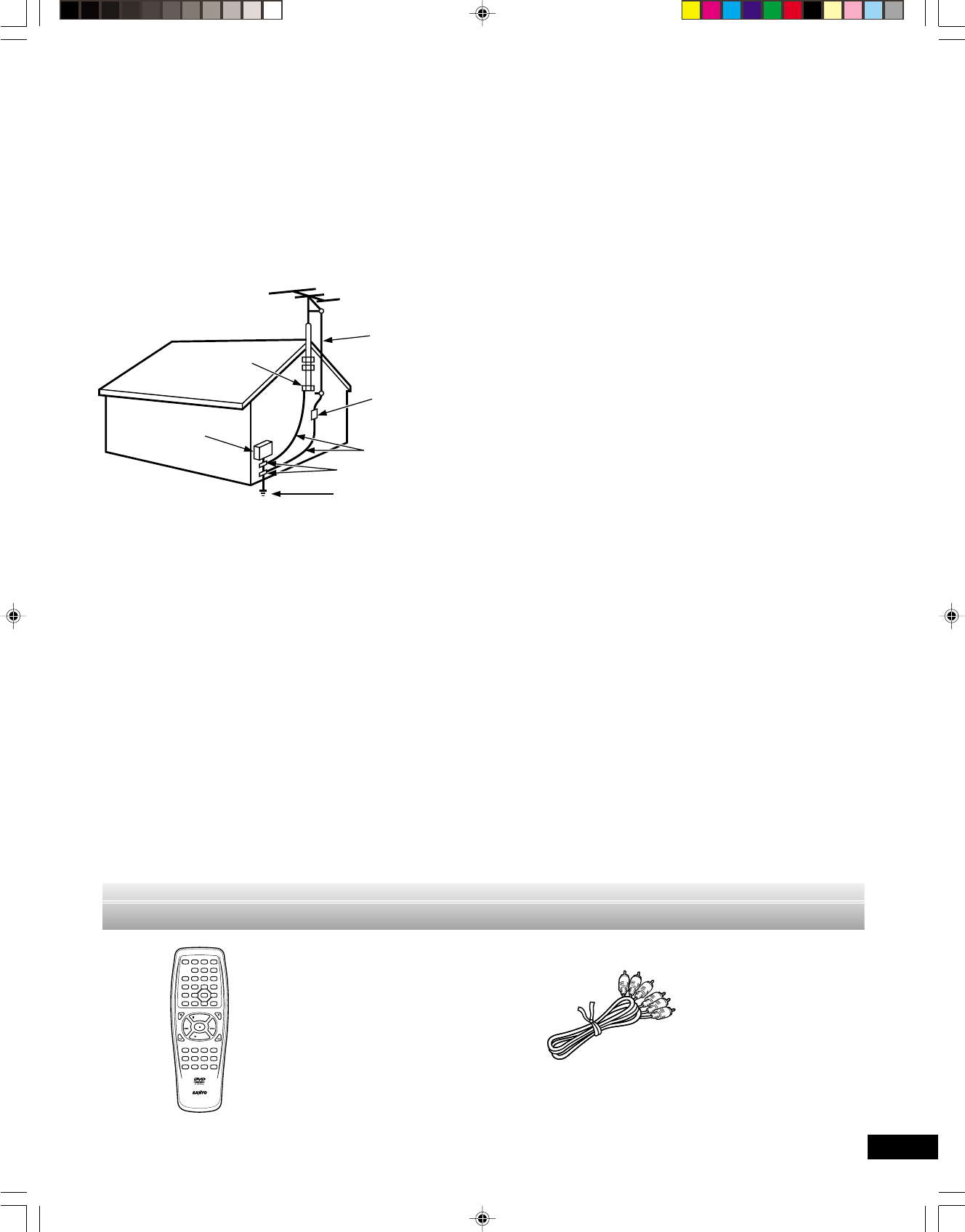
ACCESSORIES
Wireless remote control Audio/Video cable
REMOTE CONTROLLER RB-SL22
LAST MEMO
PICTURE
MODE
OPEN/CLOSE
z/ON
REPEATA-B REPEAT
PROGRAM
/RANDOM
ON SCREEN
ZOOM ANGLE
ANGLE
REPLAY
SETUP MENU
SUBTITLE
CHANGE
4
ab
5
ENT
SUBTITLE
ON/OFF
AUDIO RETURN
TOP MENU
REV SLOW FWD SLOW
PAUSE/STEP
PREV NEXT
PLAY
REV
FWD
CLEAR
123C
4560
789
SEARCH
MODE
15. Outdoor Antenna Grounding – If an outside antenna or cable
system is connected to the product, be sure the antenna or cable
system is grounded so as to provide some protection against
voltage surges and built-up static charges. Article 810 of the
National Electrical Code, ANSI/NFPA 70, provides information
with regard to proper grounding of the mast and supporting
structure, grounding of the lead-in wire to an antenna discharge
unit, size of grounding conductors, location of antenna-discharge
unit, connection to grounding electrodes, and requirements for
the grounding electrode. See Figure 2.
EXAMPLE OF ANTENNA GROUNDING AS PER NATIONAL ELEC-
TRICAL CODE, ANSI/NFPA 70
GROUND
CLAMP
ELECTRIC
SERVICE
EQUIPMENT
ANTENNA
LEAD IN
WIRE
ANTENNA
DISCHARGE UNIT
(NEC SECTION 810-20)
GROUNDING
CONDUCTORS
(NEC SECTION 810-21)
GROUND CLAMPS
POWER SERVICE GROUNDING
ELECTRODE SYSTEM
(NEC ART 250, PART H)
NEC – NATIONAL ELECTRICAL CODE
S2898A
(Figure 2)
16. Power Lines – An outside antenna system should not be
located in the vicinity of overhead power lines or other electric
light or power circuits, or where it can fall into such power lines
or circuits. When installing an outside antenna system, extreme
care should be taken to keep from touching such power lines or
circuits as contact with them might be fatal.
17. Overloading – Do not overload wall outlets, extension cords,
or integral convenience receptacles as this can result in a risk of
fire or electric shock.
18. Object and Liquid Entry – Never push objects of any kind
into this product through openings as they may touch dangerous
voltage points or short-out parts that could result in a fire or elec-
tric shock. Never spill liquid of any kind on the product.
19. Servicing – Do not attempt to service this product yourself
as opening or removing covers may expose you to dangerous
voltage or other hazards. Refer all servicing to qualified service
personnel.
20. Damage Requiring Service – Unplug this product from the
wall outlet and refer servicing to qualified service personnel un-
der the following conditions:
a. When the power-supply cord or plug is damaged.
b. If liquid has been spilled, or objects have fallen into the
product.
c. If the product has been exposed to rain or water.
d. If the product does not operate normally by following the
operating instructions. Adjust only those controls that are
covered by the operating instructions as an improper ad-
justment of other controls may result in damage and will
often require extensive work by a qualified technician to
restore the product to its normal operation.
e. If the product has been dropped or damaged in any way.
f. When the product exhibits a distinct change in perfor-
mance – this indicates a need for service.
21. Replacement Parts – When replacement parts are required,
be sure the service technician has used replacement parts speci-
fied by the manufacturer or have the same characteristics as the
original part. Unauthorized substitutions may result in fire, elec-
tric shock, or other hazards.
22. Safety Check – Upon completion of any service or repairs
to this product, ask the service technician to perform safety checks
to determine that the product is in proper operating condition.
23. Heat – The product should be situated away from heat
sources such as radiators, heat registers, stoves, or other prod-
ucts (including amplifiers) that produce heat.
This appliance shall not be exposed to drippling or splashing
water and that no object filled with liquid such as vases shall be
placed on the apparatus.
-E4-
DVD-SL33/CA(English) 13/06/2003, 10:065


















